Concepts is an infinite, flexible creative tool for all your good ideas. Available on iOS, Windows and Android.
Scale and Measurement in Concepts
A Concepts Tutorial for iOS
Learn how to apply accurate scale and measurements to your plans and drawings.
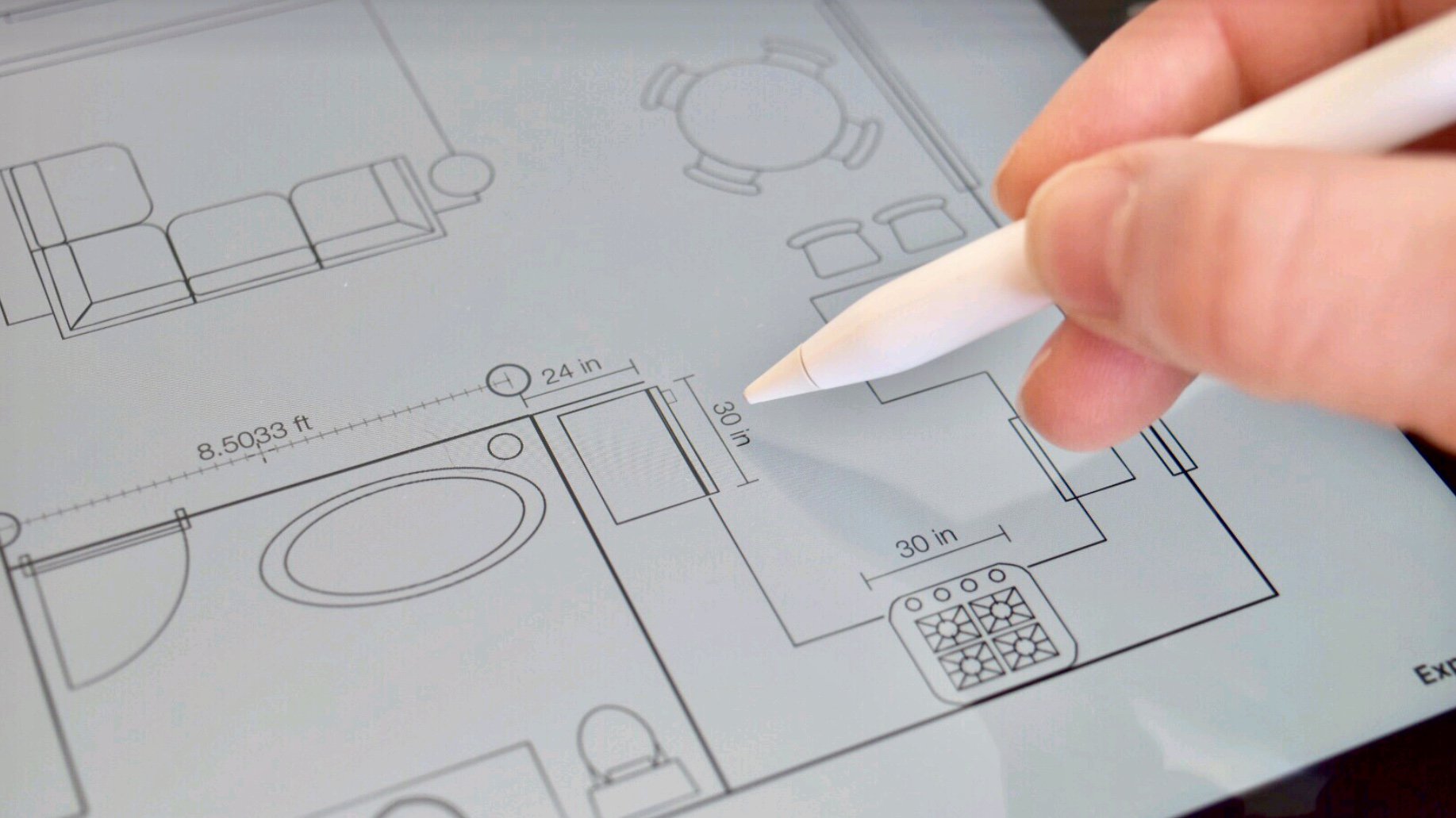
The first steps in drawing a design plan are 1) setting your project’s scale and 2) applying accurate measurements. A successful plan needs to communicate both your overall vision and how its pieces fit together accurately, so that when it comes time to estimate costs, purchase materials and build your final design, you can do it with confidence.
Concepts makes it simple to set your drawing scale for a project, align a plan with the app for accurate measurements, and apply a known scale to an imported plan or image. You can also draw and trace lines to exact dimensions, and apply measurement tags to your designs.
Scale
Scale is a multiplier that defines how big an object is in real life compared to its size on the screen. Standard scales for house plans, for example, are 1/8 in or 1/4 in : 1 ft imperial (in the US), or 1 : 100 metric (everywhere else). This indicates that 1/8 in or 1/4 in on the plan equates to 1 ft in reality. Component drawings might be 1 : 20 or 1 : 5; gaming models are popularly 1 : 72. For smaller objects where details matter, a scale of 1/2 : 1 allows you to see the design at twice the size.
Applying Scale to a New Drawing
If you’re creating a new design from scratch and know the scale you’d like to use for your design, make a new drawing and open the Settings menu (the gear icon in the status bar). In the Workspace tab, find Drawing Scale.
Here, you can easily select one of the standard ratios or enter your own scale. Tap an entry field to bring up a full list of options or type in your units with the keyboard. Tap the corresponding unit field beside the numbers to enter your unit type.

Drawing Scale and Units options in the Settings menu.
Next head down to Units (immediately below Drawing Scale) to match your drawing’s unit setting to the scale you applied. This makes the unit displayed on canvas reflect your scale metrics. (Note that every tool and guide will reflect this metric, as well… it doesn’t mean your tool presets have changed, they’ll just be displayed with the new unit.)
From here on, everything you draw will reflect the scale you’ve set regardless of zoom levels. When you open the Precision menu on canvas, you’ll see this scale ratio displayed beside the Measure option. Tap the ratio or head back to Settings (it’s the same screen) to adjust the scale at any time.

The Precision menu with Measure active.
Read about applying measurements that reflect this scale with Concepts’ rulers down below under Measurements.
Applying Scale to an Imported Drawing
If don’t know a scale but want to accurately reflect your plan’s real-world components on screen, you can line up a known real-world measurement with a measurement on canvas, and the app will calculate the scale for you.
The Short Version
1. Have an accurate measurement of a real-world dimension on hand.
2. Import your plan.
3. Tap the Precision menu and activate Measure.
4. Activate the Line guide. Double-tap the crosshairs. Align the handles to the segment on your plan that corresponds with your real-world measurement.
5. Tap the ratio beside Measure in the Precision menu and enter your real-world measurement into the second field. When you exit the overlay, you’ll see the new scale ratio, 1:your-new-calculated-value.
The Illustrated Version
1. You can align any PDF or image to a particular scale on your canvas. To tie your design on screen to its real-world counterpart, it’s important that you know one real-life measurement of your plan. Check your plan for an already-noted measurement, or take out your tape measure and find an exact measurement of one wall, door, lot line or deck length. If you need to, jot it down on your canvas to remember it.

With an infinite canvas, you can write anywhere and still have room for your plan.
2. Import your plan onto the canvas. Drag+drop it onto the canvas from another app or double-tap the Import button to open the Imports tab.

You can import any photo or PDF and align it to a scale.
If you import the plan as an image or PDF, it will appear in its own layer, default with automatic layering. If you’re in manual layering mode, it will appear in the current layer.
If it’s a complex or colorful image, we recommend you tap the image layer and set the opacity down to ~40% so you can see your sketching and measurement tags clearly on the plan.
If the plan is discolored or needs cleaning up, try taking a screenshot and running it through a photo-filter first on high contrast. This keeps the main lines of the plan clear while washing out the background. Then import it into Concepts and use the hard eraser to mask out any extra marks.
3. Tap the Precision menu open. Find Measure from the options that appear, and tap it to activate it.

Activate Measure.
4. Now find Guide, right below Measure. You might see an arc or other option beside it – tap it to display the rest of your choices and tap the Line guide active. (By the way, if something is selected on your screen, you won’t see the Guide option – just make sure nothing is selected.)
You’ll use this Line guide to align your scaled measurement to your plan.
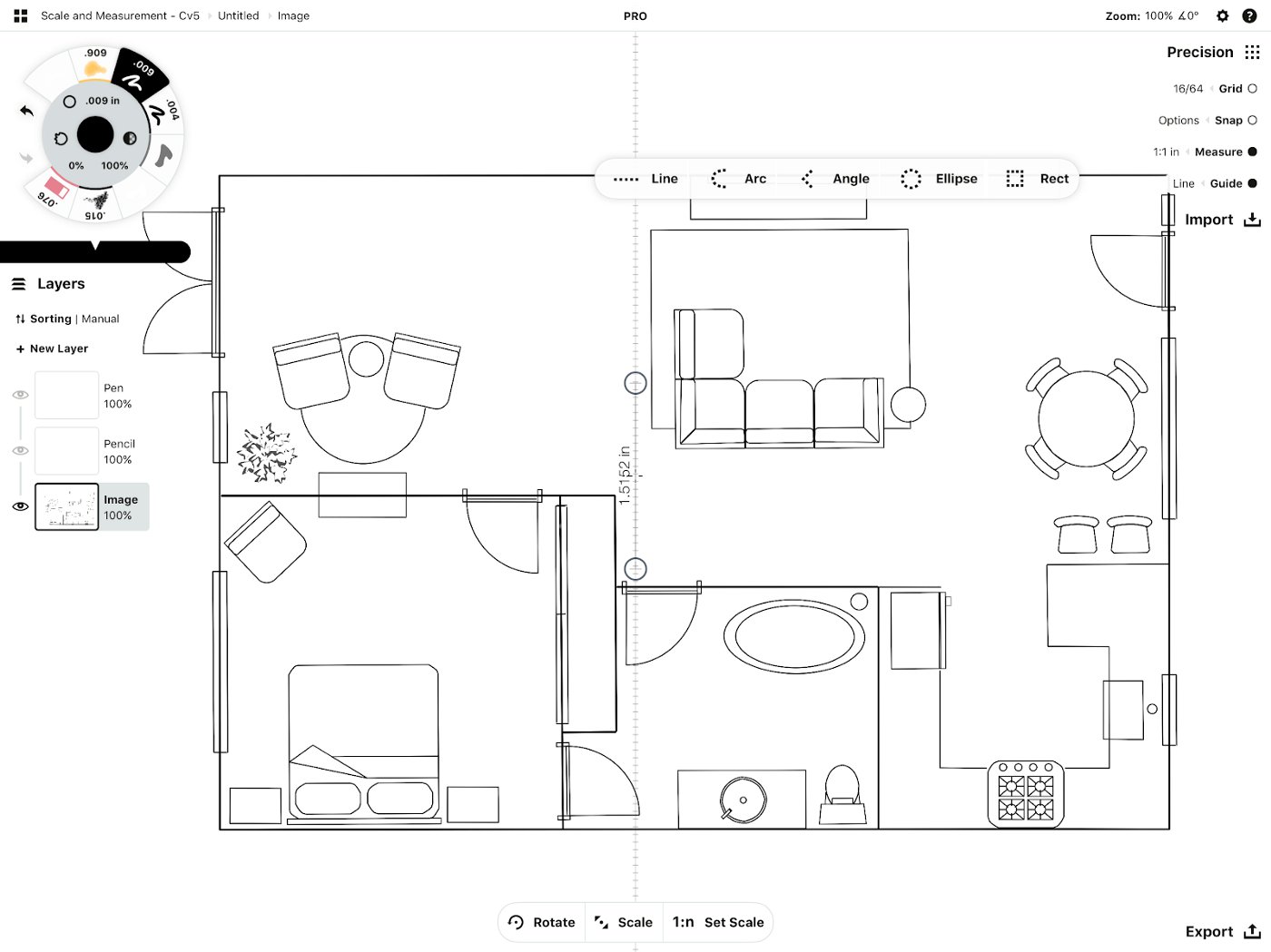
The rest of the Shape Guides work with Measure just like the Line guide. Use them to apply exact radii, angles and perimeters to your shapes.
The Line guide is one of Concepts’ smart rulers (100% Smoothing + Measure is another). Besides helping you trace straight lines, it measures your lines as you draw when Measure is active, and allows you to customize its length.
Activate the Line guide and double-tap the crosshairs at the center. This contains the boundaries of the line and keeps you from tracing beyond any measurements you’ve set.

Contain the boundaries of the guide by double-tapping the crosshairs at the center.
Align the handles on your plan to the same segment of wall or other length that you measured in real life. The measurement on the guide will not be the same as your real-world measurement yet — that’s okay.

.5 inches does not equal 24 inches… yet. In this case, the depth of the counters lines up to half an inch, but yours might be different. The app will calculate the scale regardless of what the measurement is.
5. Tap the ratio beside Measure in the Precision menu. (You can also access this ratio under Settings -> Workspace.)
You’ll notice the values in the Drawing Scale fields have been filled with the current length of the Line guide according to the current scale and units of the drawing.

The ratio is still 1:1, but the “0.5 in” value in each field is the same as the measurement aligned to the counter on the plan.
Now take your real-world measurement and enter it into the second field. Then tap anywhere to dismiss the menu.

Ignore the first field, and enter your real-world value into the second field.
When you look at the ratio beside Measure on the canvas, you’ll see a new ratio – 1:your-new-calculated-value. The .5 inch tag on the plan now reads 24 inches.

The ratio is now 1:48 inches, and your measurement now reads 24 inches.
What this did was match the line length on screen to the actual value of the line in real life. Half an inch on the plan is now the same as the 24 inch cabinet depth, or a 1:48 inch scale. From here on out, your scale will reflect in all of the measurements on canvas regardless of zoom level.
Aligning an Imported Drawing to A Known Scale
If you’re importing a plan and want to align it to a particular scale, you’ll also need to know one real-life measurement on your plan.
The Short Version
1. Have an accurate measurement of a real-world dimension on hand.
2. Import your plan into a new layer.
3. Lower the layer opacity to ~50%.
4. Open the Precision menu and tap the scale ratio beside Measure. Enter your known scale and units into the Drawing Scale fields. Also define your units for the drawing in the Units section below.
5. Activate Measure.
6. Draw a line with the Line guide or with 100% Smoothing to the length of your real-world measurement.
7. Select your imported plan and scale it larger or smaller until the measured segment on your plan aligns with the line you drew.
The Illustrated Version
1. Make sure you have one real-world measurement from your plan on hand. It can be a wall, lot line, cabinet depth, door or anything else on your plan. This will be used to align the plan with the app.

Know your measurement before you start, and measure twice.
2. Import your plan into a new layer.
To import, drag+drop it onto the canvas from another app, or double-tap the Import button to open the Imports tab.
If your layers are in Automatic mode, the image will import by default into the bottom-most layer. If they are in Manual mode, it will import into your active layer. You can select and drag the image into a new layer and drag layers up or down as necessary. Set it as the bottom layer so you can see anything you draw over the top.

The image layer is at the bottom.
3. Lower the opacity of the layer to ~50%. This is important because when you select and scale the image later, you’ll need to be able to see through it to match it to your measurement.
To lower the opacity, tap the image layer to make it active, then tap it again to bring up the layer’s menu. Use the slider at the bottom to lower the opacity of the layer.

Lower the opacity so you can line up the image layer with the measurement you’ll draw.
4. Open the Precision menu and tap the scale ratio beside Measure.
Enter your known scale and units into the fields. Head to the Units section below and define your drawing metric so it corresponds with your scale metric.

This is the same Drawing Scale field found in Settings -> Workspace. You can change it from either place at any time.
5. Open the Precision menu and tap Measure active. All of your strokes will now display measurement tags beside them.

Measurement tags with Line Smoothing.
6. Using the Line guide as described above, or by setting a tool’s smoothing to 100%, trace or draw a straight line onto the canvas that is the exact length of the real-world dimension from your plan. It helps to do this in a layer above the imported image layer.
• If you use the Line guide, just tap+hold the measurement tag to enter your exact length. Then trace the line between the handles. (Double-tap the crosshairs to keep your line between the handles.) Tap the measurement tag to “stick” it to the canvas.
• If you use 100% smoothing, draw the line, select it, then tap+hold the measurement tag to enter your exact length. Tap the tag to set it to the canvas.

1. Select the line you drew. 2. Tap+hold the measurement tag or length field in the status bar. 3. Enter your exact value and tap Done. 4. Tap the measurement tag.
7. Select your imported plan and scale it larger or smaller until the line you drew corresponds with your known measurement on the plan.
Set Rotate to Off on the selection menu so it doesn’t twist around. Keep Scale or Stretch on so you can resize the image.

Then zoom in or out afterward so your plan is comfortably in view.
You’ll see that any lines you draw with Measure now align accurately with your plan.
Measurement
We’ve covered a few things about the Measure feature already while setting up your scale. Here are a few more tips on how to use Measure in your designs.
Measurement Tags
Now that you’ve set the scale for your plan, you can apply scaled measurements to your drawing.
When Measure is active in the Precision menu, any line you draw will have a measurement associated with it, whether you’ve drawn freehand, used smoothing, used a Shape Guide or imported an object. Measure measures everything. These measurements reflect the current scale and units of your drawing.
By tapping a measurement tag, you will “stick” it to the canvas as a floating tag. Tags made with line smoothing apply to the end of the line. Tags made with the Line guide look a little more like traditional measurements. Choose whichever method works best for you.

To edit a measurement tag, select it using Item Picker. Then edit the measurement by tap+holding the tag or the corresponding length field in the status bar (this “L:x” field is only visible when a measurement is selected).
To delete a measurement tag, select it using Item Picker, then tap the trash button on the popup.
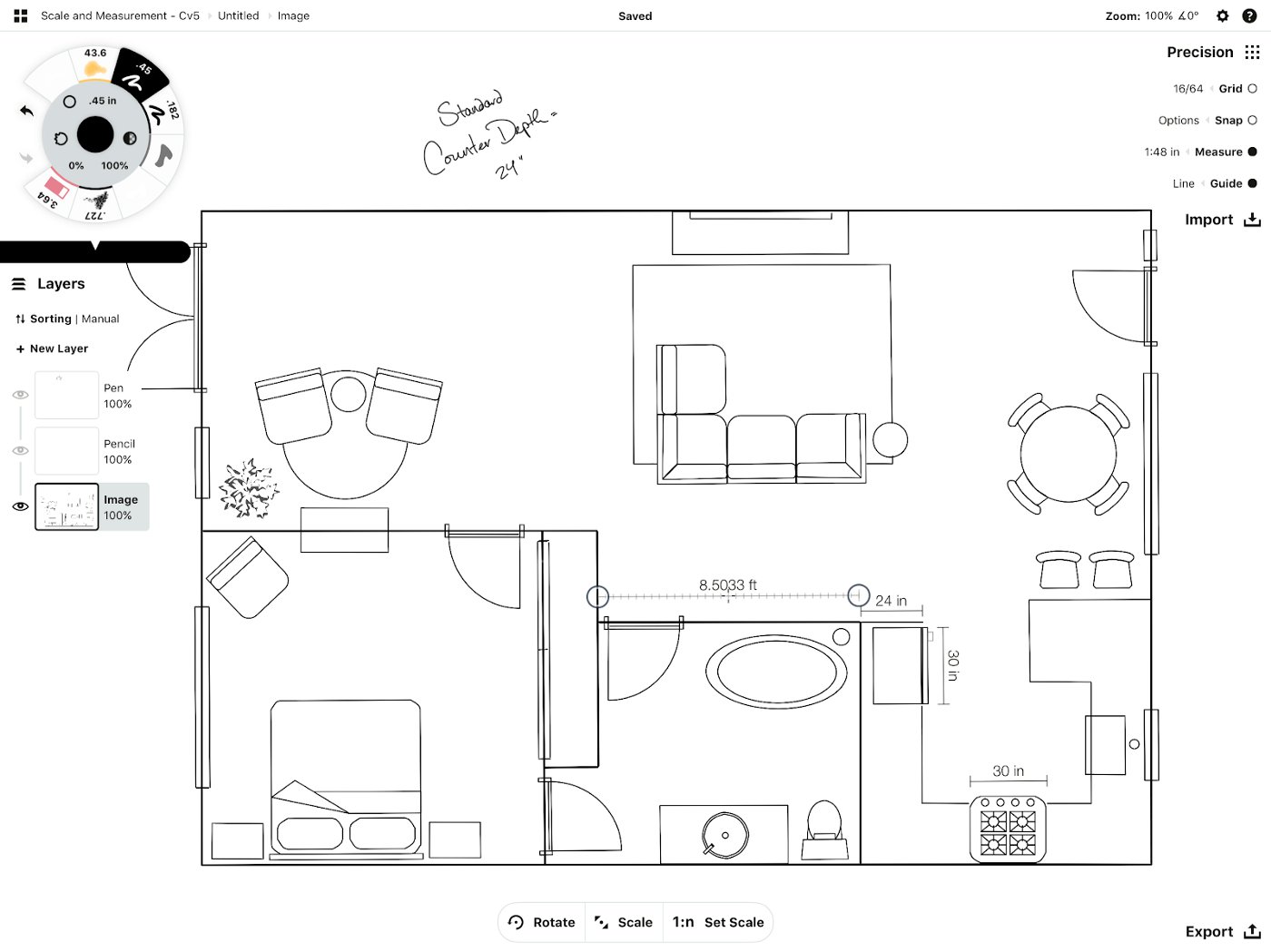
Adding floating measurement tags to the plan.
To rotate a line an exact number of degrees, select the line, then tap+hold the angle value in the status bar and choose from the shortcuts or enter a number. To rotate the Line guide an exact number of degrees, just tap+hold the angle value and enter the new angle.
To apply the same measurement to other locations, you can select and duplicate lines with their tags, or move the Line guide and apply floating tags. It’s helpful to turn the Scale button to “Off” in the selection popup at the bottom of the screen, then move the guide to its next position. That way you don’t inadvertently change the measurement by pinching with your fingers when you rotate.

Tap the Scale button on the selection popup to “Scale Off” so the measurement stays the same when rotating or moving the guide.
Alternatively, you can turn the Line guide off and select the tag using Item Picker, duplicate it and move it like any other line.
Customizing Measurements
If you want to customize your line length, tap+hold the measurement tag on the Line guide, or the Length value in the status bar, and a custom entry screen will appear. Enter in the length and units. You’ll see the guide updates to the dimensions you entered.
You can do the same with lines drawn with 100% smoothing. Draw the line, select it, then tap+hold the measurement tag or the Length value in the status bar to bring up the keyboard. Enter in your value and the line will adjust.
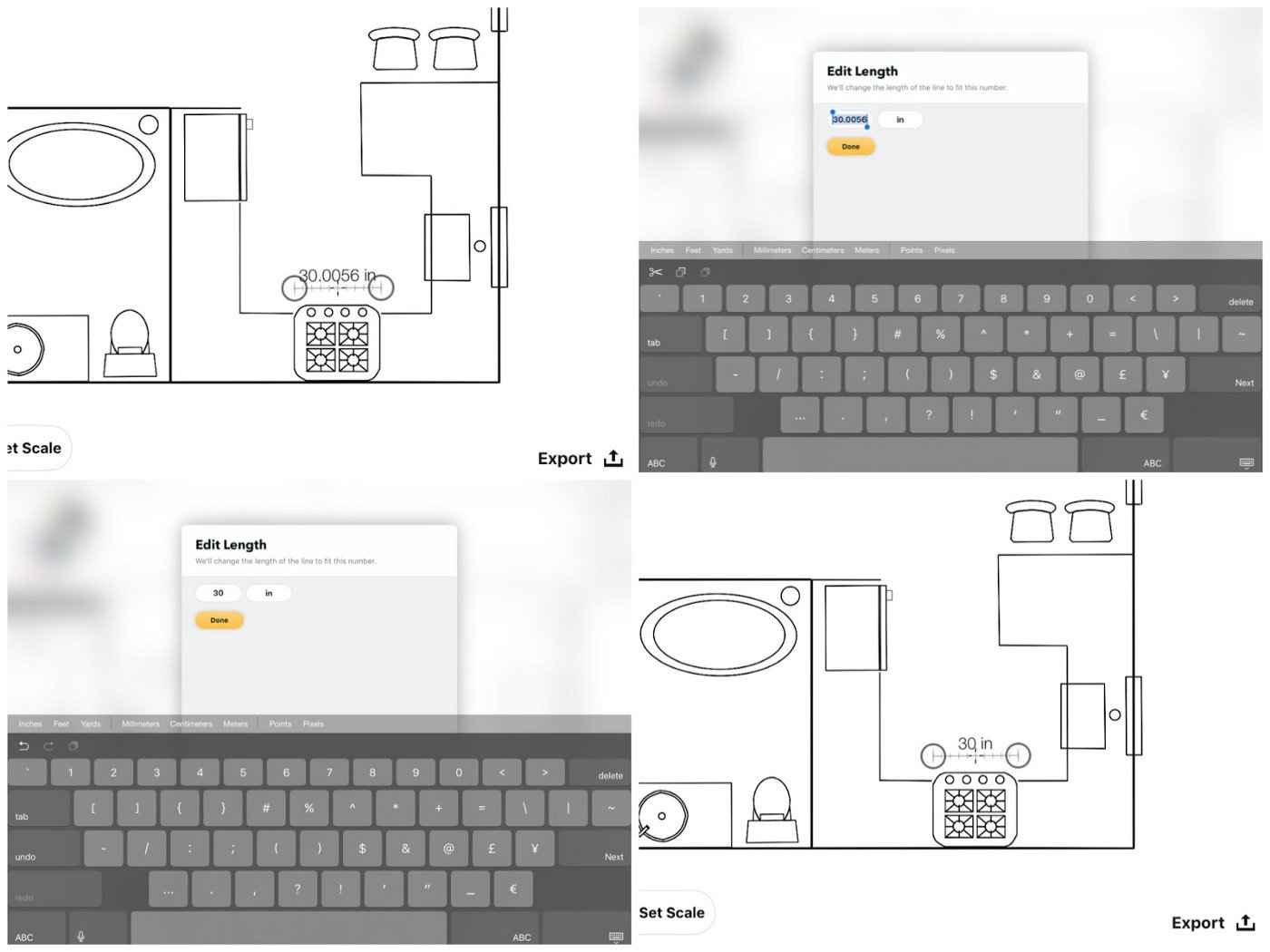
1. Tap+hold the measurement tag. 2. The custom measurement overlay appears. 3. Enter in the new length. 4. Exit the overlay and find the adjusted value.
Drawing with Measurements
When drawing with 100% smoothing, Concepts tracks the distance you draw from the point you set your stylus onto the canvas to the point you take it off. Head back and it subtracts the distance. This is ideal for freehand drawing with measurements.
When tracing the Line guide, the total distance your stylus draws will be calculated into the measurement, including backtracking along the line. Tracing precisely between the handles keeps the measurements clean.
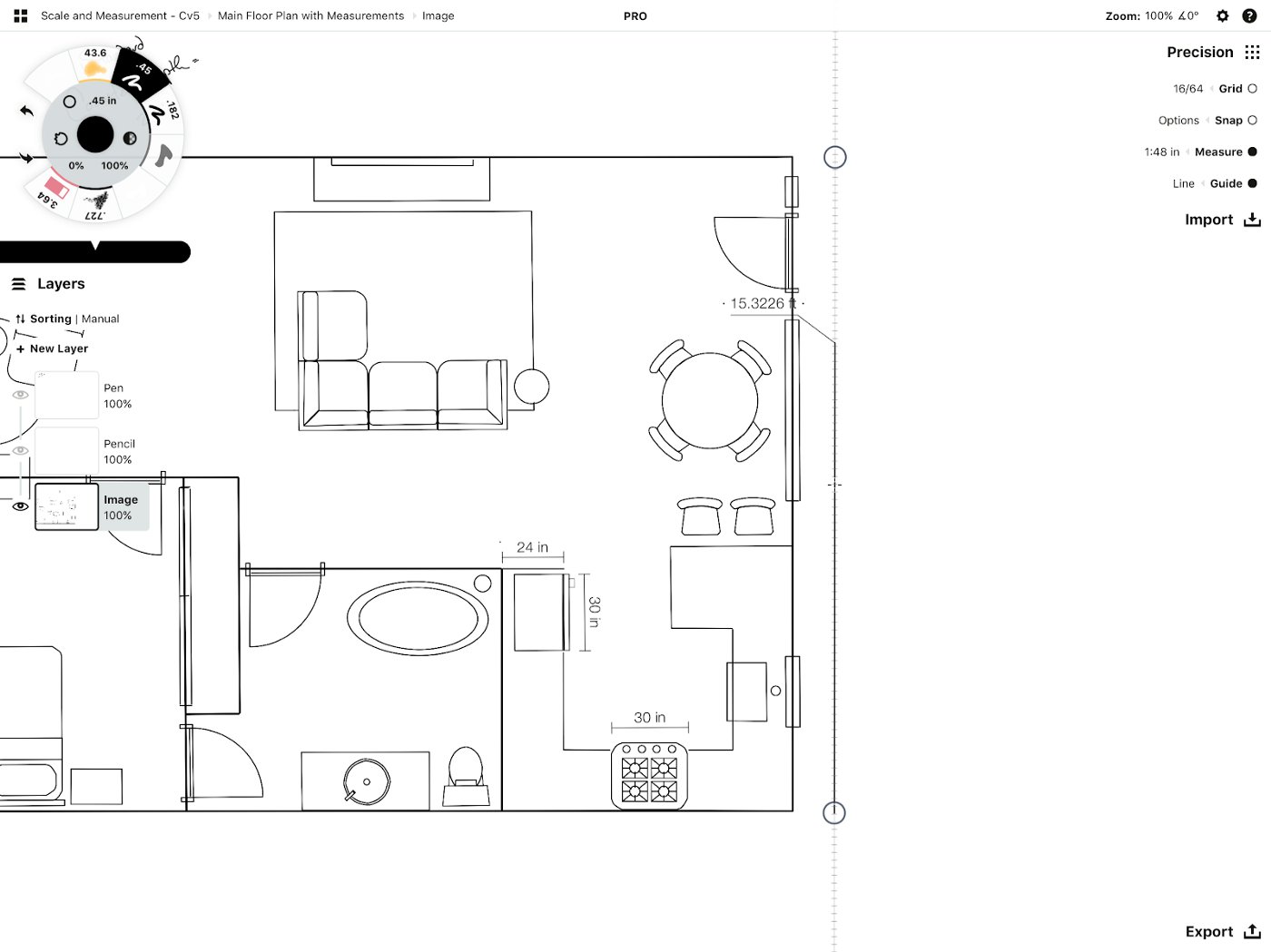
Finding measurements actively with the Line guide.
The better option for drawing to exact measurements with the Line guide is to double-tap the crosshairs, then tap+hold the measurement to set it to a custom length. When you trace the Line guide from one end to the other, it will reflect the measurement.

Drawing a line to an exact measurement.
Exporting with Measurements
Ready to export your plan? If you want to show your measurements in the final export, make sure Measure is active to capture them in your image or PDF.
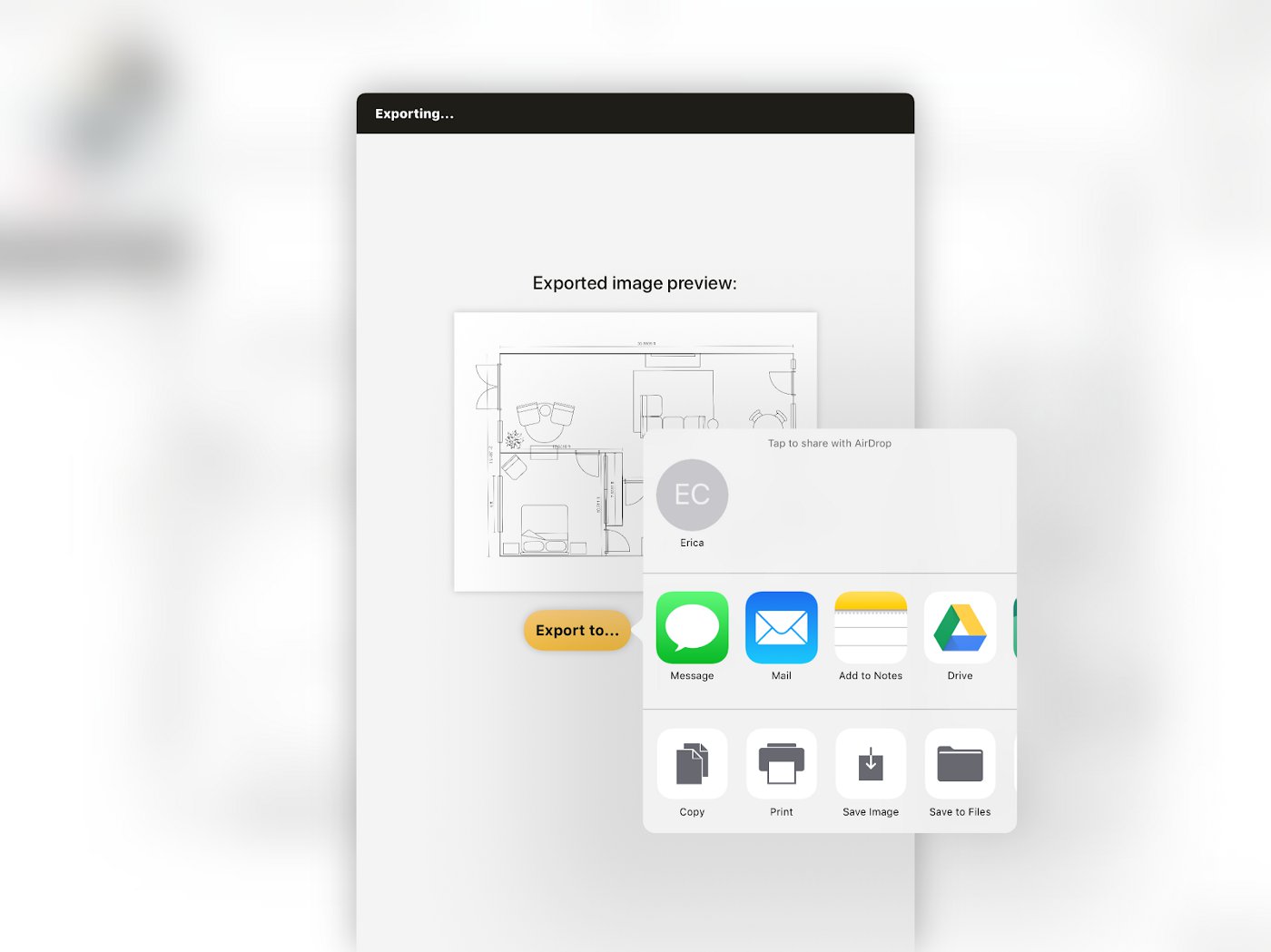
Exporting a plan with measurements.
If you don’t want to show them in the export, just turn Measure off. The measurements will still be there when you turn it back on.
If you have any questions about applying scale or measurements in Concepts, please email us at [email protected] or head in-app to Help -> Ask Us Anything. We’ll be happy to help.
By Erica Christensen
Recommended
How to Create a Floor Plan – Everything you want to know about creating a floor plan in Concepts.
How to Use Layers to Take Notes, Illustrate and Design – Learn how to use Concepts’ layers to take notes, illustrate and design your projects.
A Practical Evolution of Ideas and Tech in Architecture – Architect Ewen Miller shares how he uses Concepts and the iPad Pro to design improvements for residential communities in the UK.